Colourful clocks, refreshingly cold frothy beer, stunning mountain scenery or the swell music of oompah bands entertaining on board as you cross Lake Constance… what is it that warms Germany’s welcome and makes the place tick?
Is the ‘Bavarian Sea’ really as impressive as its name suggests? Just how beautiful are alpine Inzell’s painted houses? Is the Königssee fit for a King and why does the Bavarian lion stand guard at Lindau harbour?
We can’t give you all the answers, but we’d like to share some background to a few of our favourite amazing places included in our German cycling holidays.
Find out more about cycling across Bavaria – from Munich to Salzburg
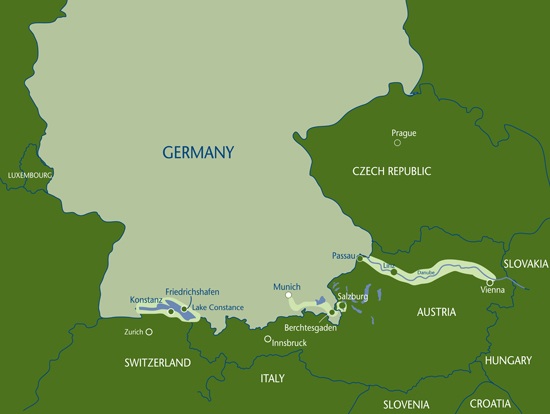
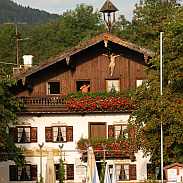 Bad Feilnbach
Bad Feilnbach
Situated in the Rosenheim district nicknamed ‘Bavarian Merano’ thanks to its mild climate and abundance of green meadows and fruit trees, this unassuming town is little more than a village but with a big reputation for its healing properties. It boasts miles of countryside footpaths, but as its name suggests, it has won fame through its spa and wellness opportunities. Here though it is not the salty waters that are the attraction, but the local mud which is enjoyed by the therapeutic bathload!
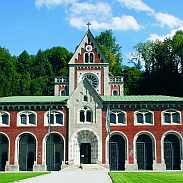 Bad Reichenhall
Bad Reichenhall
In the Berchtesgardener Land region of Bavaria, this smart, stately but distinctly friendly spa town, owes its history to the health-giving salt springs of the area and is officially Germany’s first certified alpine wellness location. Its historic centre is dominated by the impressive Ludwig Strasse pedestrian precinct and Kurpark (health spa park) which hosts regular outdoor concerts. The town has a significant reputation for its cultural offering and events, including its very own Philharmonic Orchestra. Visit the Alte Saline, old salt mine and the 13th C. Romanesque Minster of St Zeno.
Bad Tölz
Sitting at the crossroads of two major historic trading routes (the Isar and the old salt route from Reichenhall to Allgäu) in the alpine foothills, this fine town has a medieval heart and is brimful of richly decorated Baroque houses which are testimony to its rich trading past. The Stadtsmuseum (town museum) unlocks the local story from both inside and out, but a wander through the market streets, charming alleys and squares soon reveals café and beer garden gems. The town turned its attention to its natural springs in the 19th C. becoming Bad Tölz as late as 1899 and has a significant modern spa complex on the western bank of the Isar.
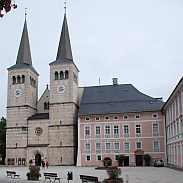 Berchtesgaden
Berchtesgaden
Situated within Germany’s only alpine National Park, this compact town represents everything which you think Bavaria should be. Watched over by the 2713m/ 8900ft Watzmann, the country’s second highest mountain, it is framed by six mountain ranges and edges on to the most beautiful alpine lake, the Königssee. The town has an inviting spa park with wonderful alpine views and an unusual austere castle – the original seat of a small church state which became the summer residence of the Bavarian royal family in 1810. On the top of the nearby Kelstein mountain sits the Eagle’s Nest (now a restaurant) with amazing views over the Obersalzberg and fascinating tales to tell about its daring construction and notorious resident, Adolf Hitler.
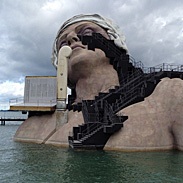 Bregenz
Bregenz
Situated at the foot of the Alps, Bregenz is noted for its lake stage and festival. The town is a good spot for shopping, or take a cable car to the top of the Pfander mountain for panoramic views.
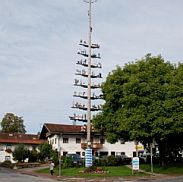 Lake Chiemsee
Lake Chiemsee
Often referred to as the ‘Bavarian Sea’, Lake Chiemsee is 30 square miles of sparkling tidal waters surrounded by the most stunning alpine scenery and criss-crossed by an extensive ferry network joining the lakes stylish resorts and villages and its two inhabited islands: Herreninsel, site of Bavaria’s largest castle built to lavish tastes by King Ludwig II in the late 19th C. to imitate Versailles. Fraueninsel is home to the Benedictine Abbey of Frauenwörth with its distinctive onion-shaped dome.
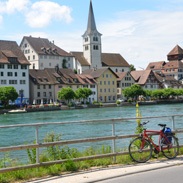 Diessenhofen
Diessenhofen
Former imperial town, noted for its lovely covered wooden bridge over the River Rhine, alongside numerous well-preserved Gothic houses, a fine church and fortifications.
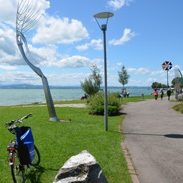 Friedrichshafen
Friedrichshafen
The area’s second largest town, once noted for its construction of Zeppelin airships. Take a walk along the lakeshore path with its lovely views of the Alps and busy harbour.
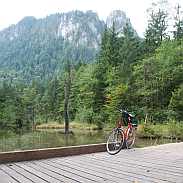 Inzell
Inzell
Nestling in a wide, Alpine valley in the Traunstein district of Bavaria, this pretty little town full of picturesque farm houses is surrounded by the greenest meadows, wonderful mountains and the clearest lakes. It is known locally for its traditional festivals and colourful costumes and many of its houses are fine examples of the local decorative painting tradition of ‘Lüftlmalerei’. The town is particularly renowned for its major outdoor artificial ice-skating rink, home to the international speed skating championships.
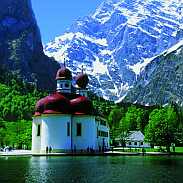 Königssee (Lake Königssee)
Königssee (Lake Königssee)
Could this be the most impressive alpine landscape in Germany? This narrow, 5 mile long fjord-like lake is surrounded by the steepest rock cliffs. Take the electric boat trip out onto the still waters for a chance demonstration of the unique echo effect phenomenon and to enjoy the full impact of the most awesome water-mountain-sky vistas. The white and orange reflection of the ‘floating’ St Bartholomew’s church against the harsh mountain backdrop is a real must see and evening cruise options can make the experience even more magical.
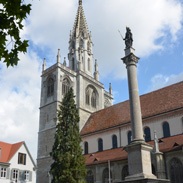 Konstanz
Konstanz
Lively university town – the biggest settlement on the shores of Lake Constance. Set beside the mouth of the Rhine and dating from Roman times, it has a rich and important history (such as the great Council of Konstanz 1414-18 which elected Pope Martin V), alongside a great mix of sights, culture and leisure activities.
Kreuzlingen
Adjoining Konstanz, but just over the border in Switzerland, Kreuzlingen is noted for its well-kept Seeburg Park which stretches 2.5 miles alongside the water’s edge with its castle and gardens.
Lake Constance/Bodensee
Bordered by three countries – Germany, Austria and Switzerland, this extremely picturesque area is where the River Rhine has created a lake with a 270km shoreline surrounded by pretty towns and villages noted for their fine architecture, castles and Baroque churches. There are spectacular views of the Alps and the clear waters offer plenty of bathing, boating and leisure activities.
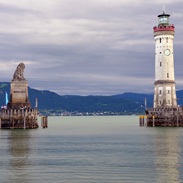 Lindau
Lindau
Set on an island, Lindau was once noted for its textiles. The town has lovely timbered houses, floral displays, arcades and fountains. At the harbour, look out for the famed marble Bavarian lion.
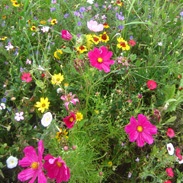 Mainau
Mainau
Known as the ‘island of flowers’, Mainau was transformed into a floral paradise by Count Lennart Bernadotte in 1932. Attractions include the Rose garden, majestic castle and butterfly house.
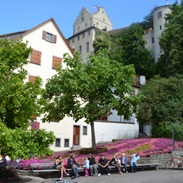 Meersburg
Meersburg
Surrounded by numerous vineyards, this attractive town has an historic centre with picturesque streets and two castles. In the Middle Ages it paid host to the Bishops of Konstanz.
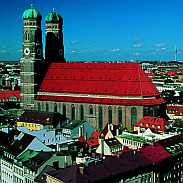 Munich/München
Munich/München
The third largest city in Germany, Munich is the capital city of Bavaria, located on the River Isar north of the Bavarian Alps. The city’s name comes from the word for monks (Mönche) who were the original founders. There’s plenty of impressive architecture, much of it restored after wartime damage. The town hall on the main square (Marienplatz) is a must not only for the splendour of its ornate facade but particularly because of its musical clock which has 43 bells and 32 life-sized figures which up to 3 times a day move to the chimes in a 15 minute story-telling spectacular. There are three remaining gates from the city’s medieval fortifications and many churches of renown including the Frauenkirche which serves as the cathedral. Museum lovers will be spoilt for choice in the neo-Gothic Maximilianstrasse area which leads to the Maximilianeum, home of the state parliament, and the streets of designer shops and big name stores are a real treat for any would-be shopper.
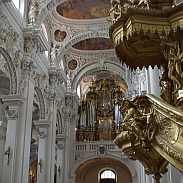 Passau
Passau
Known as the city of three rivers, this university city on the German/Austrian border is at the confluence of the Danube, Inn and Ilz. Its history goes back to Roman times, but during the Renaissance period it won special renown for the manufacture of quality weaponry, when blacksmiths stamped blades with the sign of the Passau wolf which superstitious warriors believed conferred invulnerability. Today the city is an architectural
delight – best experienced on a river trip to get an understanding of scale and importance. St. Stephen’s cathedral, an amazing example of Italian Baroque architecture, has a magnificent pipe organ – only surpassed as the world’s largest in more recent times by a church organ in Los Angeles. Veste Oberhaus, the former fortress of the Bishop, sits on the wooded mountain crest between the Danube and Ilz.
Reichenau Island
With its tree-lined causeway, vegetable growing and vineyards, this World Heritage Site is famous for its monastery and well-preserved churches from the 9-11th C.
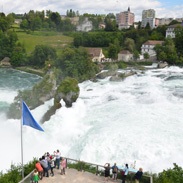 Rheinfalls
Rheinfalls
Europe’s largest waterfall, a magnificent and awe-inspiring sight, with several spectacular viewpoints looking out over the powerful and thundering flow of water.
Romanshorn
Home to an important harbour (one of the largest on the lake for privately owned craft), this attractive-located town has waterside gardens to relax and take in the views.
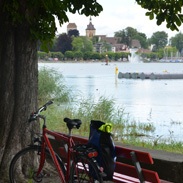 Rorschach
Rorschach
Linked to the fortunes of the convent at St. Gallen, Rorschach became a major point for trading trips into Italy. Overlooking the lake the main street has lovely 18th C decorated buildings.
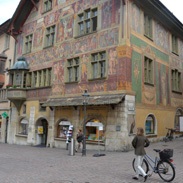 Shaffhausen
Shaffhausen
This well-preserved Medieval town set on the river Rhine is dominated by the imposing Munot fortress, with streets lined with old buildings from the Gothic and Baroque periods.
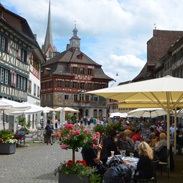 Stein am Rhein
Stein am Rhein
Overlooked by the Hohenklingen castle and set alongside both sides of the River Rhein, this is one of the best preserved towns of its type in the whole of Switzerland.
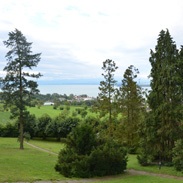 Ueberlingen
Ueberlingen
Popular spa and holiday resort set beside the Uberlinger See. A former trading post, it’s history dates back to the 12th C. Visitors can see the late Gothic cathedral, ramparts and defensive towers.
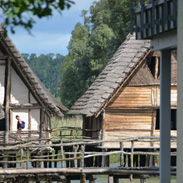 Uhldingen
Uhldingen
Home to an open-air museum with a set of reconstructed lake dwellings (buildings on stilts) from the Stone/Bronze Age periods, based on prehistoric remains found in the area.





